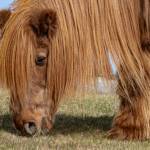PPID Research: Probing Dopamine, Brain Receptors in Horses

According to some reports, one in five horses over the age of 15 years has pituitary pars intermedia dysfunction (PPID, equine Cushing’s disease), yet the exact cause of this condition remains unknown. Without a detailed understanding of what goes awry in the pituitary gland, vets may not be offering horses the best treatment.
“Based on our current understanding of PPID, specific neurons in the brain fail to secrete the neurotransmitter dopamine. As a result of the decreased dopamine, a cascade of events culminates in dysregulation of multiple hormones. Ultimately, hormone fluctuations result in the abnormal growth or hypertrophy of the pars intermedia region of the pituitary gland,” explained Kathleen Crandell, Ph.D., a nutritionist for Kentucky Equine Research.
These altered hormones wreak havoc on multiple body systems, resulting in excessive drinking and urination, abnormal fat deposits, hirsutism/hypertrichosis, and more. Hormonal dysregulation also leaves horses at risk for developing endocrine-associated laminitis.
In other species, research shows that dopaminergic, or dopamine-releasing, neurons decrease in Cushing’s disease, but the number of receptors that dopamine binds to, called D2Rs, also decrease. Whether similar alterations in dopamine and D2Rs occur in horses is unknown.
To better understand the role of dopamine and the D2Rs in the disease, 32 pituitary glands from horses diagnosed with PPID were tested for the following:
- Microscopic severity of any abnormal pituitary growth;
- Presence of neurons that secrete dopamine in the pituitary glands; and
- The number of dopamine receptors in the pituitary glands.*
“Dopamine levels, which were estimated based on measuring an enzymatic biomarker of dopamine production called tyrosine hydroxylase, decreased as microscopic grade of the pituitary growth increased in severity,” Crandell explained.
Finding low dopamine levels in the face of the abnormal growth of the pituitary gland confirms that researchers are on the right track to more fully understanding PPID. It also supports using pergolide to treat PPID, as pergolide is a D2R agonist, which means it acts like dopamine to stimulate the D2Rs.
“What was not expected, however, was an increased expression of dopamine receptors in the pars intermedia region of the pituitary,” Crandell noted.
According to the research team, the increased D2Rs could simply reflect a compensatory response to the decreased dopamine, meaning the body creates more receptors to maximize the response from dwindling dopamine. More research into these D2Rs is warranted, and further studies are needed to tack down the finer details regarding pathogenesis of PPID.
“Because PPID horses are particularly susceptible to oxidative stress, resulting in increased infections and depressed immune function, affected horses may benefit from vitamin E supplementation,” recommended Crandell.
Supplementing with vitamin E should be performed in conjunction with other management strategies aimed at maximizing the health and welfare of horses with PPID.
*Huang, L., C. Palmieri, and F.-R. Bertin. 2022. Correlation of pituitary histomorphometry with dopamine and dopamine D2 receptor expression in horses with pituitary pars intermedia dysfunction. Research in Veterinary Science 152:427-433.








